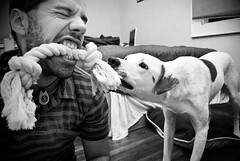 Judging by the popularity of cat and dog videos on the Internet, it seems safe to say that pets have assumed an important role in our society.
Judging by the popularity of cat and dog videos on the Internet, it seems safe to say that pets have assumed an important role in our society.
However, as Benedict Carey explores in a recent NY Times article, the pet’s position within the family can be a contentious topic.
“The big bone of contention was that my mom and my sister thought that he was too smart to be treated like a dog; they thought he was a person and should be treated as such — well, spoiled,” said Danielle, a Florida woman who asked that her last name not be published to avoid more family pet strife. “The dog remains to this day, 10 years later, a source of contention and anger.”
To understand human pet relationships, Carey turns to the field of sociology. David Blouin, a sociologist at Indiana University, explains that there are three basic categories of belief concerning pets. “Dominionists” who see pets as a useful, and beloved, but ranked below humans and replaceable. “Humanists,” who cherish their pets and raise them to the same status as a favored child. And, “protectionists,” who base their views on what they think is “best” for the animal.
“These are ideologies, and so protectionists are very critical of humanists, who are very critical of dominionists, and so on,” Dr. Blouin said. “You can see where this can create problems if people in a family have different orientations. Every little decision about the pet is loaded.”
And, whether you believe Fido should be in the yard or snuggling under the down comforter at night may not simply be a matter of personal preference. Rather, as sociologist Elizabeth Terrien helps us understand, views vary by class, ethnicity and geographic location.
One clear trend that has emerged is that people from rural backgrounds tend to see their dogs as guardians to be kept outside, whereas middle-class couples typically treat their hounds as children, often having them sleep in the master bedroom, or a special bed.
Terrien explains, the cultural and class-based differences in understanding how a pet should be treated can lead to groups judging each other negatively.
In neighborhoods with a larger Latino immigrant population, owners were more likely to say “protector,” or even “toy for the children,” she found. “In those neighborhoods you’ll sometimes see kids yanking around a dog on the leash, pushing and playing, the sort of behavior that some middle-class owners would think of as abuse” she said.
Carey’s article provides an important reminder that sometimes even the most personal – for instance, family arguments over whether the dog is included in the will – is linked to larger social forces. Also, Carey confirms yet again that class matters, even for dogs and cats.

Comments